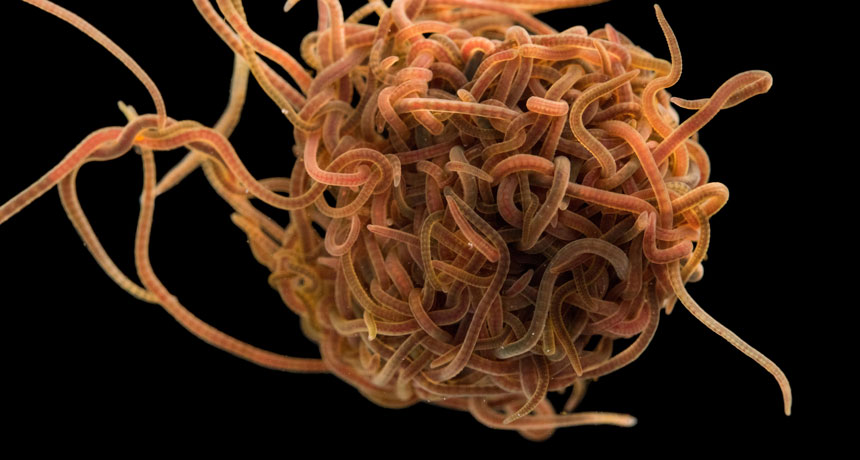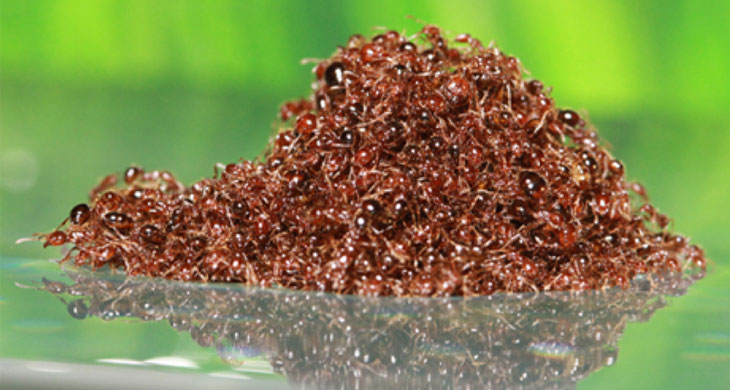How worm blobs behave like a liquid and a solid
Scientists are studying how the animals move collectively when tangled together by the thousands

ALL TANGLED UP Worms tangled together in a blob can move collectively, flowing through pipes like a liquid but also showing properties of solids.
National Geographic Image Collection/Alamy Stock Photo
TAMPA, Fla. — Blobs of worms flow like a fluid, plop like a solid and fascinate scientists.
A worm by itself is as solid as any other living animal. But a mass of aquatic California blackworms tangled together flows through a tube like a liquid. Pouring, heating and otherwise playing with blobs of worms shows that a tangled mass of them has properties of both fluids and solids, Saad Bhamla reported January 5 at the annual meeting of the Society for Integrative and Comparative Biology.
A blob can hold itself together like a solid: When released to fall a short distance on a hard surface, it plops instead of splashing, Bhamla, a biophysicist at Georgia Tech in Atlanta, said. And video from his lab also revealed a worm blob version of melting. In a container of water where a hot spot develops, the blob starts fraying and “melts” away as some blackworms (Lumbriculus variegatus) disentangle themselves and swim off, while others collectively move to a spot with a lower temperature. Adding chilly water, however, will cause the blob to solidify again as the animals rejoin the ball.
Blobs of worms that ooze along as a mass might help advance the study of biological physics, Bhamla said. Unlike some more famous animal group behaviors, such as birds flocking or fish schooling, worms tangling in a blob nudge against each other and transfer forces directly. Such contact matters in some of biophysics’ profound questions about how little bits of soft matter come together as multicellular life.
Aquatic California blackworms in a lab aren’t the only worms that know how to gather together. Pinkish masses that twitched when prodded by sewer inspectors in North Carolina raised some hopes of alien contact in 2009, but turned out to be earthly species. Free-roaming, moisture-sensitive worms will also clump into wriggling tangles when stranded on asphalt.
Worms that join a blob may have a better chance of escaping death by dehydration when marooned out of water, Yasemin Ozkan-Aydin, also of Georgia Tech, proposed January 6 at the meeting. In experiments exposing blackworms to air, a loner is usually dead within an hour, she found. In a thousand-worm mass, though, about 20 percent of worms are still alive after 18 hours.
Her various tests of blob behavior inspired abundant musing from the audience on such mysteries as how the blobs stay together or whether individuals in a clump can be tracked. Biologist Colleen Unsworth of the University of Akron in Ohio wondered whether there were signs of specialized roles in a blob like those of ants that serve as anchors when a colony builds a living bridge. To these and most questions, Ozkan-Aydin said that she hadn’t yet worked out a good way to track individuals and much about worm blobs is still unknown.
Fire ants can also mass together as a living material, a collective behavior that has long fascinated David Hu, also of Georgia Tech. Arrays of ants trap enough air for a colony to turn into its own life raft and safely float along in a flood (SN Online: 6/17/14).
ln an overview January 5 of fire ants’ collective constructions, Hu noted that they, like worm blobs, have qualities of both a solid and a fluid. Viscosity analyses show that dropping a penny into a mass of ants would be like dropping the coin into yogurt. Good to know in case anyone wants to pick up a spoon and dig in.







